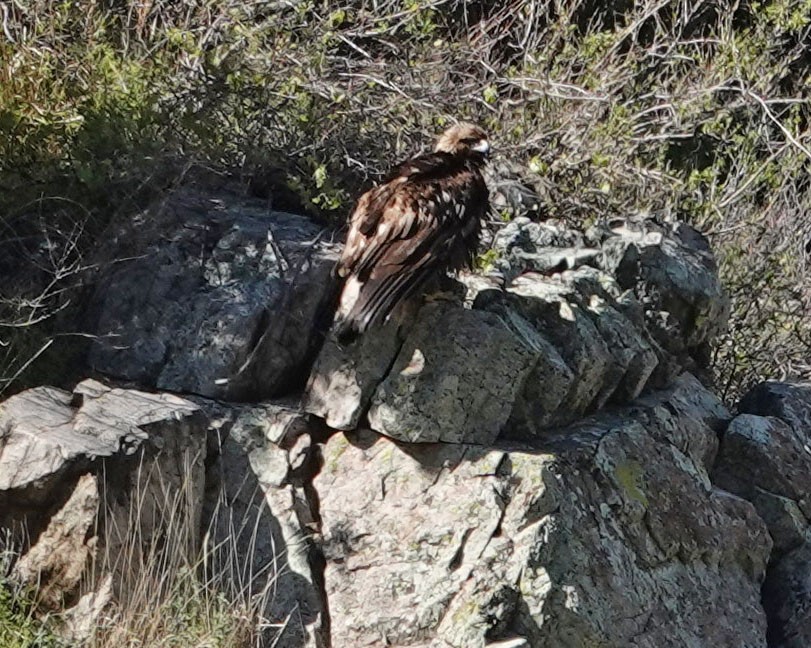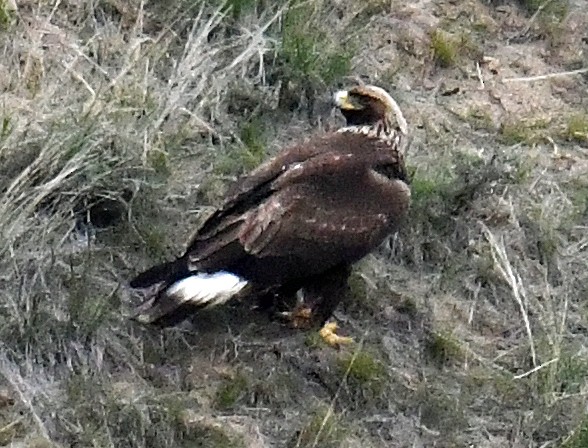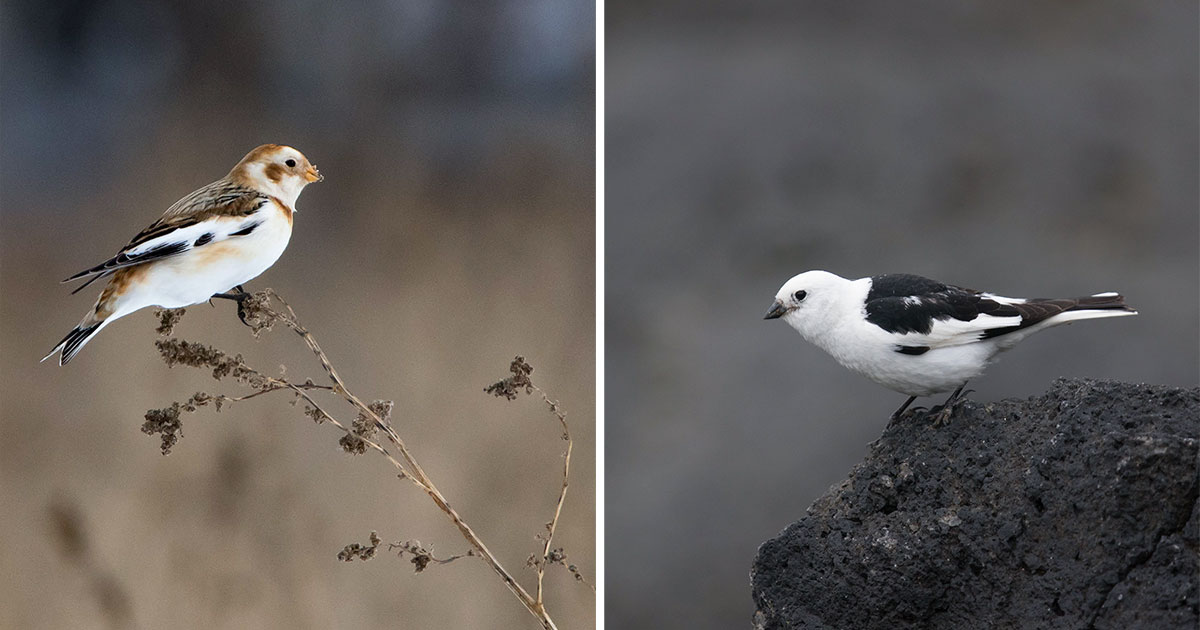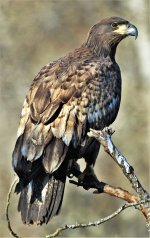-
Welcome to BirdForum, the internet's largest birding community with thousands of members from all over the world. The forums are dedicated to wild birds, birding, binoculars and equipment and all that goes with it.
Please register for an account to take part in the discussions in the forum, post your pictures in the gallery and more.
You are using an out of date browser. It may not display this or other websites correctly.
You should upgrade or use an alternative browser.
You should upgrade or use an alternative browser.
Juvie Bald or Golden? (1 Viewer)
- Thread starter kgbpasha
- Start date
More options
Who Replied?Sangahyando
Well-known member

Looks like Bald Eagle. You can just make out the naked tarsi (GE would have feathered "trousers" all the way down), and the bill size and overall pattern are also better for Bald.
Deb Burhinus
Used to be well known! 😎

Nice image of a juvenile (2cy) Bald Eagle 🙂
note a similar age GE still has an fairly darkish bill, more clearly defined white banded tail and light feathering on the nape

 macaulaylibrary.org
macaulaylibrary.org

 macaulaylibrary.org
macaulaylibrary.org
note a similar age GE still has an fairly darkish bill, more clearly defined white banded tail and light feathering on the nape
ML223120291 - Golden Eagle - Macaulay Library
Macaulay Library ML223120291; © Cathy Beck; Pima, Arizona, United States
ML219069841 - Golden Eagle - Macaulay Library
Macaulay Library ML219069841; © Marilyn Hedges; Chelan, Washington, United States
Last edited:
connorco
Well-known member

Correct me if I'm wrong, but I don't think a 2cy Bald Eagle could be could be classified as a juvenile. It should be referred to as an immature bird.Nice image of a juvenile (2cy) Bald Eagle 🙂
note a similar age GE still has an fairly darkish bill, more clearly defined white banded tail and light feathering on the nape

ML223120291 - Golden Eagle - Macaulay Library
Macaulay Library ML223120291; © Cathy Beck; Pima, Arizona, United Statesmacaulaylibrary.org

ML219069841 - Golden Eagle - Macaulay Library
Macaulay Library ML219069841; © Marilyn Hedges; Chelan, Washington, United Statesmacaulaylibrary.org
Deb Burhinus
Used to be well known! 😎

I disagree with you, sorry.Correct me if I'm wrong, but I don't think a 2cy Bald Eagle could be could be classified as a juvenile. It should be referred to as an immature bird.
‘Juvenile’ refers to the plumage (juvenal) - ‘2cy’ refers to the calendar year - the two are not mutually exclusive at this stage of development. Once it moults out of juvenile plumage later in the 2cy, it can be said to be in basic 1 plumage or young immature or just 2cy. The iris will then have become lighter and there will be noticeable moult limits in the flight feathers with the newer ones more rounded and shorter. If you don’t know how to correctly age a bird, it is also acceptable to call anything other than an adult, ’immature’.
Last edited:

There has been much confusion on the matter of juvenile vs immature with some people saying that the words in non-technical literature should be synonymized!. Having said that, the usage that a bird in its first fully feathered plumage is a juvenile for how ever long it stays in that plumage is commonly considered correct.
Niels
Niels
Deb Burhinus
Used to be well known! 😎

This is the only point I was making really - the bird in the OP is still in the plumage attained when replacing the down feathers, so calling it a ‘juvenile’, even though it is in it’s second calendar year, is not just commonly but technically correct....the usage that a bird in its first fully feathered plumage is a juvenile for how ever long it stays in that plumage is commonly considered correct.
Niels
If we want to describe birds by their plumage, we refer to ‘juvenile’, first winter, second winter, first basic, 2nd basic, pre-alternate etc etc. If we want to refer to birds by age, then we use the calendar year during which or after which they were born. A bird, eg a passerine, ceases to become a juvenile, once it has had it’s post-juvenile moult, it then becomes a first winter, even if it is only a few months old. A gull for another example, can be in it’s first winter plumage yet in it’s second calandar year.
Last edited:
kevinsl06
Well-known member
Correct me if I'm wrong, but I don't think a 2cy Bald Eagle could be could be classified as a juvenile. It should be referred to as an immature bird.
I have to agree with this. A second year bird should be called immature not juvenile.
Deb Burhinus
Used to be well known! 😎

Well I know Americans have different ways of labelling plumages but to say a 2cy Bald Eagle in juvenile plumage cannot be regarded as a ‘juvenile’ makes absolutely no sense from an ornithological perspective - at least in how we approach moult definitions etc outside of America.I have to agree with this. A second year bird should be called immature not juvenile.
A bird is recognised as a ‘juvenile’ because of its plumage NOT it’s age. Raptors as a rule carry juvenile plumage for the first 12 months of its life from nestling. A Bald eagle in March of it’s second calendar year is only approximately 8 months old and still in juvenile plumage. Some smaller species of raptor, like falcons and harriers, will have a partial body moult in their first winter, so will be regarded as in a transitional plumage (between juvenile and first basic).
A Bald Eagle does not start moulting out of its juvenile plumage until about 12 months after fledging ie in their 1st summer (2cy - July/August). Feel free to check any of Derek Forsman’s publications on raptors - Flight Identification of Raptors 2016, is full of images of various raptors (including White-tailed Eagles) referred to as ‘juveniles’ despite being in the Spring of their second calendar year.
Perhaps those people saying I am wrong here, would please explain how they would define a ‘juvenile’ bird?
Edit - Btw - if the date that the photo was taken was actually the 3rd of December, rather than the 12th of March (given the American habit of writing the month before the day), my point remains. The OP would still be a juvenile in juvenile plumage but in its 1cy. not 2cy
Last edited:
Deb Burhinus
Used to be well known! 😎

So checking in case this is a cultural misunderstanding (giving my critics the benefit of the doubt 😉), this is how the National Aubudon Society describe ‘juvenile’
After a bird goes through its first juvenile molt, it only changes feathers sequentially, which means it always has something old and something new on its body. That's why late-winter gulls that are immature (the awkward stage between juvenile and adult) look so “patchy.”

 www.audubon.org
www.audubon.org
So Cornnorco/kevins or anyone else confused about moult terminology, hopefully this has been of some help ... clearly, American ornithologists follow the same definitions.
“What is “juvenile” plumage?
The juvenile stage refers to the period right after a fledgling leaves the nest. For some species it lasts just a few days; for others it can take up to a year. This is also the only time in a bird’s life when all of its feathers grow in at the same time, giving it a particularly uniform appearance. Take the young Western Sandpiper, for example: It's crisp and clean-looking, almost like a recently detailed and upholstered car.After a bird goes through its first juvenile molt, it only changes feathers sequentially, which means it always has something old and something new on its body. That's why late-winter gulls that are immature (the awkward stage between juvenile and adult) look so “patchy.”

Understanding the Basics of Bird Molts
As the seasons change, so do birds' feathers. A birder should be prepared.
So Cornnorco/kevins or anyone else confused about moult terminology, hopefully this has been of some help ... clearly, American ornithologists follow the same definitions.
Last edited:
Charlotte1
Member
Hi Deb. As someone who has just started birding, I find you explanation really helpful as I find a lot of your
other posts. Your help is appreciated.
other posts. Your help is appreciated.
Nutcracker
Stop Brexit!
Except for a few who got mixed up with a Roman poet! 😂... clearly, American ornithologists follow the same definitions.
Fortunately that spelling mistake (first made IIRC by Kenneth Parkes) has largely died out now
Deb Burhinus
Used to be well known! 😎

Thanks Charlotte - all too often it’s easy to forget that at times 😉Hi Deb. As someone who has just started birding, I find you explanation really helpful as I find a lot of your
other posts. Your help is appreciated.
Users who are viewing this thread
Total: 2 (members: 0, guests: 2)




